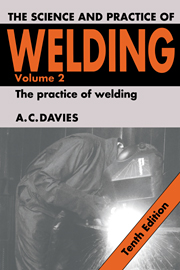Book contents
- Frontmatter
- Contents
- Preface
- 1 Manual metal arc welding
- 2 Gas shielded metal arc welding
- 3 Tungsten electrode, inert gas shielded welding processes (TIG), and the plasma arc process
- 4 Resistance welding and flash butt welding
- 5 Additional processes of welding
- 6 Oxy-acetylene welding
- 7 Cutting processes
- 8 The welding of plastics
- Appendixes
- 1 Welding symbols: British, American
- 2 Simplified notes on the operation of a thyristor
- 3 Proprietary gases and mixtures
- 4 Tests for wear-resistant surfaces
- 5 Conversion factors
- 6 Low hydrogen electrode, downhill pipe welding
- 7 The manufacture of extruded MMA electrodes
- 8 Notes on fire extinguishing
- 9 Table of brazing alloys and fluxes
- 10 Latest plant and equipment
- 11 Refraction and reflection
- 12 Notes on the welding of Duplex and Super Duplex stainless steels
- 13 Welding fumes: health and safety
- 14 Lasers and laser welding
- City and Guilds of London Institute examination questions
- Index
8 - Notes on fire extinguishing
Published online by Cambridge University Press: 11 May 2010
- Frontmatter
- Contents
- Preface
- 1 Manual metal arc welding
- 2 Gas shielded metal arc welding
- 3 Tungsten electrode, inert gas shielded welding processes (TIG), and the plasma arc process
- 4 Resistance welding and flash butt welding
- 5 Additional processes of welding
- 6 Oxy-acetylene welding
- 7 Cutting processes
- 8 The welding of plastics
- Appendixes
- 1 Welding symbols: British, American
- 2 Simplified notes on the operation of a thyristor
- 3 Proprietary gases and mixtures
- 4 Tests for wear-resistant surfaces
- 5 Conversion factors
- 6 Low hydrogen electrode, downhill pipe welding
- 7 The manufacture of extruded MMA electrodes
- 8 Notes on fire extinguishing
- 9 Table of brazing alloys and fluxes
- 10 Latest plant and equipment
- 11 Refraction and reflection
- 12 Notes on the welding of Duplex and Super Duplex stainless steels
- 13 Welding fumes: health and safety
- 14 Lasers and laser welding
- City and Guilds of London Institute examination questions
- Index
Summary
For a fire to occur we need oxygen, fuel and heat.
Oxygen is present in the atmosphere and in the compressed form contained in cylinders used for oxy-acetylene or oxy-propane cutting.
Fuel may be any combustible substance such as petrol, diesel oil, paper, cleaning materials, rubber or litter etc. – anything that will burn.
Heat may be supplied by discarded cigarette ends, match sticks and, in the welding shop, by sparks from the arc or bad connections such as those at the earth or return terminal to the set. The arc is an intense source of heat and, together with the sparking, will rapidly cause ignition of any combustible solids or liquids in the immediate vicinity.
If any one of these above causes is removed, the fire will be contained. For example the oxygen supply from the atmosphere may be contained by smothering the fire with a blanket or dry sand or by turning off the oxygen supply if it is from a cylinder. The heat can be controlled by ceasing to use the arc and switching off all power supplies to prevent further arcing at poor contacts.
- Type
- Chapter
- Information
- The Science and Practice of Welding , pp. 412 - 416Publisher: Cambridge University PressPrint publication year: 1993

